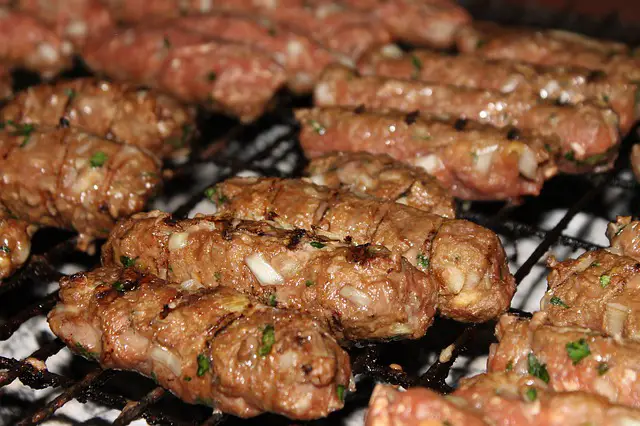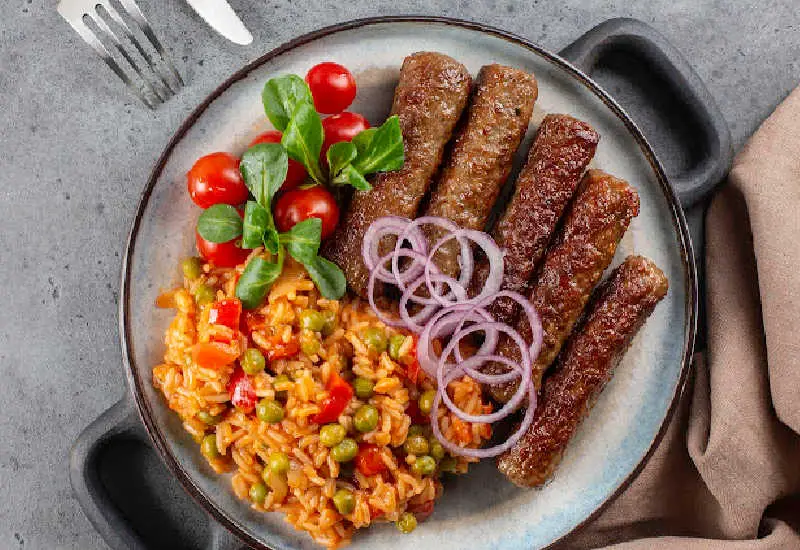Cevapi are cylinder-shaped sausages, popular in Southeast Europe, especially Serbia, Croatia, Bosnia, and Bulgaria. They provide a burst of smoky flavor and are delicious served with sliced onions and flatbread. Also known as Serbian sausages or cevapcici, they have a long history and originate from the Ottoman Empire in the Balkans.
These sausages come from a mixture of meats including lamb, pork, and beef. This is useful for helping the sausage hold its shape and also provides a unique texture and flavor. Sausage casings aren’t used which means have you don’t need a sausage stuffer to make them.
Cevapi is traditionally grilled and without casings, the smoky flavor can penetrate the meat. This results in a flavorsome sausage that has a consistent taste throughout the meat rather than all the smoky flavors absorbing into the skin.
Cevapi recipe
Makes: 24 sausages. Calories: 300kcal.
Prep time: 15 minutes. Cook time: 10 minutes. Total time: 25 minutes.
Ingredients
- ½ lb ground pork
- 1 lb ground beef
- 1¼ tsp salt
- 1 tsp ground black pepper
- 3 garlic cloves minced
- ¾ tsp baking soda
- 1 tsp paprika
Steps
- Add all the ingredients to a large bowl and mix until combined.
- Shape handfuls of meat into finger-shaped sausages, using roughly two tablespoons of mixture per sausage.
- Allow the sausage meat to bind together by laying them in a single layer on a lined baking sheet. Cover with plastic wrap before refrigerating for at least one hour.
- Preheat the grill to 350⁰F which is a high temperature, but not blazing hot. You should still be able to hold your hand 3 inches from the grate for five seconds without discomfort.
- Cook the sausages for five minutes on each side or until nicely browned. The meat should be springy with no signs of pink meat in the center.
Tips for perfect cevapi

- When choosing ground beef from the butcher or supermarket, we suggest going for 85% lean meat.
- For a fresher tasting sausage, consider grinding your own meat using rib or flank combined with chuck.
- Try to shape your sausages into a diameter of ¾-1“.
- For better flavor and a texture that doesn’t fall apart leave them refrigerated overnight before cooking.
- The use of baking soda isn’t essential so leave it out if you prefer. However, this ingredient results in a lighter, springier texture that few can resist.
- Like so many foods, cevapi will vary depending on what country you’re in. The Serbians make this sausage with a combination of lamb and beef, and sometimes add pork to the mix. Bulgarians and Croatians tend to leave out the lamb and make their sausages longer and thinner than the short, fat Bosnian ones.
How to eat Cevapi
The best way to eat cevapi is in a flatbread, such as a pita or lepinja, along with sliced sweet onion. Serve with sour cream or a sweet red pepper sauce known as ajvar. Fries or potato wedges are another popular accompaniment.
How to store cevapi
You can shape uncooked cevapi and freeze it in a single layer in an airtight container. These sausages should last two to three months when positioned at the back of the freezer. When you’re ready to use them, transfer them to the fridge and allow to thaw for a few hours. Alternatively, you can cook them on a grill without having to thaw them.

Commonly asked questions
What does cevapi taste like?
Cevapi is a mild-tasting sausage that usually has a garlicky flavor with a slightly spicy, smoky undertone thanks to the addition of paprika. It has a fine texture compared to Italian sausage and the absence of sausage casings makes it easy to chew.
What does ajvar taste like?
Ajvar is a condiment that ranges from mild through to hot and spicy and goes best with cevapi.
When is cevapi eaten?
Cevapi is a popular food that you can eat at any time of day, for breakfast, lunch, or dinner. Because its flavor is so mild, it can be paired with other breakfast foods, or with stronger flavors later in the day.
In Bosnia-Herzegovina, cafes serve it throughout the day, and you can buy it from anywhere.
Why does cevapi spit when cooked?
Cevapi tends to spit when it is cooked because it’s quite a fatty sausage, and the fat will drip down onto the flames, causing them to pop and hiss. Many people love this aspect of the sausages, which gives them more character and makes them a particularly tempting barbecue option. If you are cooking them indoors, you may wish to cover them with mesh to reduce the mess.
Can you cook cevapi in a skillet?
Some people cook cevapi on the stove, in which case a cast iron skillet will give the best results. It should let the meat brown nicely, creating a gentle sear that will bump up the flavor and make the sausages unforgettable. However, the best cevapi are often cooked on a hot grill, and they are the perfect way to make your summer barbecue stand out.
Should you add an egg?
Traditional cevapi sausages do not require eggs, but some modern recipes call for them. The egg alters the texture and helps to bind the ingredients together, so it will make your sausages less crumbly, and should help to ensure that they stick together properly. Like the baking soda, it is an optional extra that you can add in or leave out according to your personal preferences.
Summing up
The cevapi looks a lot like a kebab, thanks to its long thin appearance. It is a Balkan favorite and is a great eating sausage that is skinless. Our recipe uses cloves and paprika for seasoning which is a great combination. Unlike some sausage types that have a huge number of ingredients and pack a powerful flavor punch, cevapi is much more basic. It is likely to appeal to people that enjoy simple, smoky flavor from their meat.



Leave A Comment